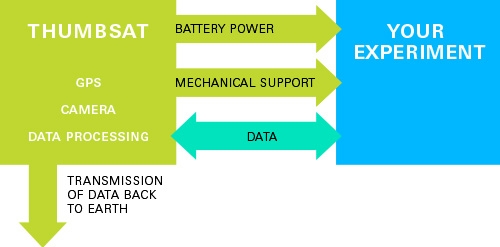The How & Why of ThumbSat

ThumbSat was born from our own frustration at not being able to find someone to get our own experiment into space quickly, cheaply and efficiently, despite our space engineering experience and contacts, and the advances in miniaturisation.
We've worked hard to make ThumbSat the sort of tiny platform for space experimentation that would have been useful for us. Many people seem to latch onto Earth imaging and communications when thinking about how a satellite can be used, but there are so many other people doing this, with much larger satellites, that there's no point in reinventing the wheel. ThumbSats can be used to image the Earth, but that's not very creative and they can be used for so much more. Everything from grabbing a promotional 'selfie' image of the ThumbSat and its decorated tail, to large projects helping to monitor and remove space junk.
If you want to look at all of the ways that we have thought of to take advantage of microgravity and hard vacuum in orbit, pop into our Virtual Classroom and check out our document about ThumbScience.
You'll discover that there are plenty of reasons to put a payload or experiment into space, but how does that work with ThumbSat? The equation is simple:
Your experiment + ThumbSat = Great results
Your experiment can be as simple as just using the on-board capability of ThumbSat, such as the camera, radio, GPS and temperature sensors.
It can be as complex as you like, within the available payload volume, mass and power availability. And remember, if you're creative, you can make most use of the tiny payload space by incorporating 'pop-out' deployable components and structures.
Our Anatomy of a ThumbSat and Mission Builder pages will help you to work out just what you might be able to achieve in space using ThumbSats. We bet you can do something great.




 Web Design
Web Design